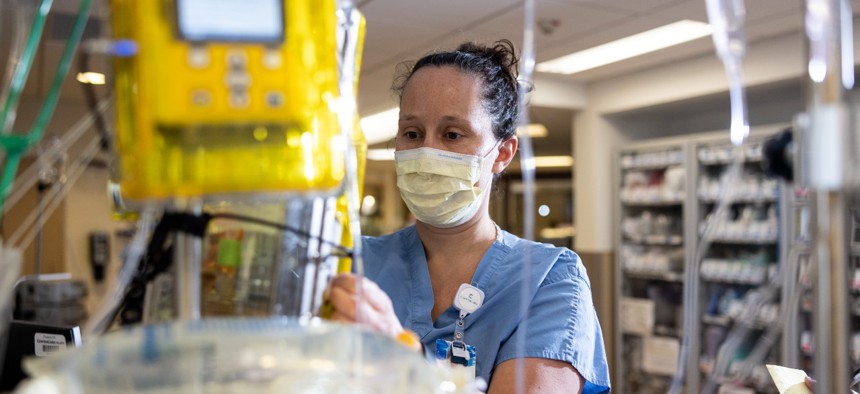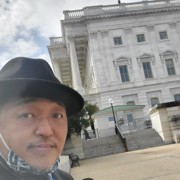Labor
The nation’s biggest public union wants to help fix the workforce shortage
The group launched a listening tour in New York and has already received feedback from state and local workers on what governments can do to attract and retain employees.

Governments are struggling to recruit and hire nurses. The nation’s largest public union wants to help change that. Jenn Ackerman /For The Washington Post via Getty Images
Tawanda Ciccone has been a 911 dispatcher for a quarter of a century. The job is hard, she says, but it’s important. “People are counting on you in emergencies that can be a matter of life and death.”
Ciccone’s job was difficult before the pandemic, but it has gotten worse as dispatchers have quit or retired and not been replaced.
“Unfortunately, we are facing a shortage of 911 employees,” she said. “We often work 16 hours straight to make up for the shortage, and the workload is simply unsustainable. We need help.”
Ciccone made these remarks last week at a press conference in Rochester to kick off the “Staff the Front Lines” national bus tour by the American Federation of State, County and Municipal Employees, the nation’s largest public union. Ciccone is one of many of AFSCME's 1.4 million members who reports being overworked and overwhelmed.
While state and local governments are making progress in staffing back up to pre-pandemic levels, they still lag behind the private sector by about 1% to 3%. Hiring managers said in a recent survey that high turnover is complicating their efforts to address workforce shortages. AFSCME is hoping the tour will give the group’s leaders a few ideas on how they can help out.
Lee Saunders, the president of AFSCME, will use the tour to create a set of policy recommendations for governments this fall for steps they can take to improve hiring.
The bus tour will take AFSCME leaders to 20 communities across 14 states. The events will also give state and local governments the opportunity to get the word out to the public about job openings and how to apply.
“We have a lot of jobs that need to be filled,” Rochester Mayor Malik Evans said at the event earlier this month, adding that many of them are for essential workers. “This work is so very important. If you call 911, it’s an essential worker that answers the phone. They keep our streets and parks clean. They collect the refuse and recycling. All these critical positions are open and pay good wages. They give real benefits.”
“We need to educate people about the kinds of jobs that are available in the public service,” adds Saunders, who previously served as AFSCME’s labor economist. “We need to talk about the vacancies.”
Already, Saunders has heard several suggestions for what local governments can do to hire more workers.
“This is a huge opportunity for labor and management to work together and talk creatively about what we can do to improve the situation,” he said.
One idea is higher wages. Better salaries would help retain and attract workers, said Wendy Smith, a public nurse in Baltimore, Maryland, who spoke one recent morning after working until 9 p.m. the night before because of staff shortages.
Smith is the president of the local union and said she is pushing for a raise in contract negotiations with the city, even after receiving a 9% increase last year, because city nurses still make less than those at private medical facilities.
Many of the city nurses left during the pandemic, Smith said, and are hesitant to return to a profession where “the working environment is unsafe. Coming out of the pandemic, a lot of people are like, ‘Do I want to bring that home?’”
Another idea is that governments could make it easier to apply for jobs in the first place.
Many, for instance, offer civil service tests once a year, said Saunders. So if a person can’t come that day, or is not looking for a job at that time, they have to wait a year at a time when governments say they are not getting enough applicants.
Tammie Latin, president of her local union chapter and a lieutenant at the David Wade Correctional Center in Homer, Louisiana, said better training would also help retain workers.
Like public health nurses, many corrections workers have quit because of the pandemic or the burnout that followed. “Everyone was scared,” she said. “They didn't want to work. Those of us who toughed it out were constantly working. It was a struggle.”
While staffing has improved, Latin says they are still understaffed, with each officer responsible for supervising 158 prisoners.
“I think they just need more on-the-job training,” she said. “I think that will help [staff] stay because they get out there and think, ‘I’ve never done this before. I’m not going to stay if you’re just going to throw me out to the wolves.’”
Saunders agreed that training would help, as would creating more apprenticeship programs.
“Since the pandemic, we really have not been able to get back to preexisting levels,” he said, adding that staffing shortages has impacted members in a very drastic way, “especially in those 24/7 operations where they're working overtime. They're burned out. They aren't seeing their families. So there's a great need on our part and on the part of the employer to relieve them of those kinds of pressures.”
Kery Murakami is a senior reporter for Route Fifty, covering Congress and federal policy. He can be reached at kmurakami@govexec.com. Follow @Kery_Murakami

NEXT STORY: NY swing district Republicans are less neutral on abortion than they promised

